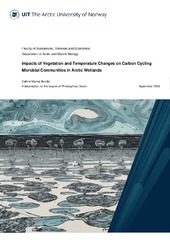| dc.contributor.advisor | Tveit, Alexander Tøsdal | |
| dc.contributor.author | Bender, Kathrin Marina | |
| dc.date.accessioned | 2023-11-06T13:16:18Z | |
| dc.date.available | 2023-11-06T13:16:18Z | |
| dc.date.issued | 2023-11-20 | |
| dc.description.abstract | Climate change causes disturbances to soil environments. Such disturbances include shifts in vegetation composition and rising temperatures, which can impact the microbial communities involved in soil carbon cycling. In this thesis, my emphasis was centered on two main aspects: the effects of vegetation changes, caused by herbivory, and the effects of temperature changes on the soil organic matter decomposition and greenhouse gas emissions in Arctic wetland soils. We applied a broad range of methods, including detailed vegetation and soil physiochemical descriptions, metagenomics and metatranscriptomics, microbial growth and biomass estimates, and greenhouse gas measurements to investigate changes in the soils and responses of the microbial communities. By combining these methods, we were able to uncover how vegetation changes can alter the activity of the soil organic matter decomposing microbial community, the soil microbial food web and the speed of the microbial loop. We were further able describe how microbial physiological adjustments to temperature change can lead to higher methane emissions during autumn cooling compared to spring and summer warming.
This thesis therefore provides valuable new insights into the dynamics of carbon cycling and greenhouse gas emissions in Arctic wetlands, based on the response of the soil microbial communities to vegetation and temperature changes. | en_US |
| dc.description.abstract | Klimaendringer forstyrrer jordsmonnet. Forstyrrelser kan forekomme som bl.a. vegetasjonsendringer og temperaturøkninger, som kan påvirke det mikrobielle samfunnet involvert i karbonsyklus. Denne avhandlingen tar for seg to hovedpunkter: Effektene av vegetasjonsendringer, som følge av fraværende planteetere, og temperaturendringer på mikrobiell nedbrytning av organisk materiale og utslipp av drivhusgasser fra arktisk myrer. Vi har anvendt et bredt spekter av metoder, inkludert detaljerte fysiokjemiske beskrivelser av vegetasjon og jordsmonn, metagenomikk og metatranskriptomikk, mikrobiell vekst og biomasse, og målinger av drivhusgass, for å undersøke hvilke endringer som forekommer i jordsmonnet og de mikrobielle samfunnene. Vi har avdekket hvordan endringer i vegetasjon endrer aktiviteten til mikroorganismene, sammensetningen av det mikrobielle næringsnettet, og omsetningen av mikrobiell biomasse. Vi var videre i stand til å beskrive hvordan mikrobielle fysiologiske justeringer som respons på temperaturendringer kan føre til høyere metanutslipp under kjøling på høsten s
ammenlignet med oppvarming på sommeren.
Denne avhandlingen gir verdifull innsikt i hvilke endringer som kan forekomme i karbonkretsløpet som et resultat av den mikrobielle responsen på endringer i vegetasjon og temperatur. | en_US |
| dc.description.doctoraltype | ph.d. | en_US |
| dc.description.popularabstract | This thesis focuses on the impact of climate change on soil environments, particularly in Arctic wetland soils. Two main aspects were emphasized:
Vegetation Changes: Climate change, including shifts in vegetation composition due to herbivory, is explored. These changes affect the microbial communities responsible for soil carbon cycling. Detailed methods, such as vegetation and soil physiochemical descriptions, metagenomics and metatranscriptomics, were used to investigate the influence of vegetation changes on the soil microbial community's activity, the soil microbial food web, and the speed of the microbial loop.
Temperature Changes: The research further explores the effects of temperature changes on greenhouse gas emissions. By utilizing various methods, including microbial growth and fermentation intermediates estimates, and greenhouse gas measurements, the study uncovers how microbial communities adapt to temperature variations. Notably, it reveals that autumn cooling can result in higher methane emissions compared to spring and summer warming.
This thesis offers valuable insights into carbon cycling and greenhouse gas emissions in Arctic wetlands, highlighting the responses of soil microbial communities to vegetation and temperature changes. | en_US |
| dc.identifier.isbn | 978-82-8266-250-5 | |
| dc.identifier.uri | https://hdl.handle.net/10037/31689 | |
| dc.language.iso | eng | en_US |
| dc.publisher | UiT The Arctic University of Norway | en_US |
| dc.publisher | UiT Norges arktiske universitet | en_US |
| dc.relation.haspart | <p>Paper 1: Bender, K.M., Svenning, M.M., Hu, Y., Richter, A., Schückel, J., Jørgensen, B., Liebner, S. & Tveit, A.T. (2021). Microbial responses to herbivory‑induced vegetation changes in a high‑Arctic peatland. <i>Polar Biology, 44</i>, 899-911. Also available in Munin at <a href=https://hdl.handle.net/10037/22778>https://hdl.handle.net/10037/22778</a>.
<p>Paper 2: Bender, K.M., Martin, V.S., Bjørdal, Y., Richter, A., Loonen, M.J.J.E., Svenning, M.M., Söllinger, A. & Tveit, A.T. Tundra vegetation changes, in absence of herbivory, are coupled with an altered soil microbial food web and a faster microbial loop. (Manuscript).
<p>Paper 3: Bjørdal, Y., Bender, K.M., Martin, V.S., Motleleng, L., Didriksen, A., Schmidt, O., … Tveit, A.T. Physiological temperature responses in methanogenic communities control the timing and rates of methanogenesis. (Manuscript). | en_US |
| dc.rights.accessRights | openAccess | en_US |
| dc.rights.holder | Copyright 2023 The Author(s) | |
| dc.rights.uri | https://creativecommons.org/licenses/by-nc-sa/4.0 | en_US |
| dc.rights | Attribution-NonCommercial-ShareAlike 4.0 International (CC BY-NC-SA 4.0) | en_US |
| dc.title | Impacts of Vegetation and Temperature Changes on Carbon Cycling Microbial Communities in Arctic Wetlands | en_US |
| dc.type | Doctoral thesis | en_US |
| dc.type | Doktorgradsavhandling | en_US |


 English
English norsk
norsk

